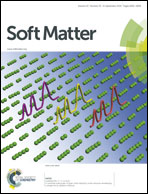Mechanism of aggregate formation in simplified industrial silica styrene–butadiene nanocomposites: effect of chain mass and grafting on rheology and structure†
Abstract
The formation of aggregates in simplified industrial styrene–butadiene nanocomposites with silica filler has been studied using a recent model based on a combination of electron microscopy, computer simulations, and small-angle X-ray scattering. The influence of the chain mass (40 to 280 kg mol−1, PI < 1.1), which sets the linear rheology of the samples, was investigated for a low (9.5 vol%) and high (19 vol%) silica volume fraction. 50% of the chains bear a single graftable end-group, and it is shown that the (chain-mass dependent) grafting density is the structure-determining parameter. A model unifying all available data on this system is proposed and used to determine a critical aggregate grafting density. The latter is found to be closely related to the mushroom-to-brush transition of the grafted layer. To our best knowledge, this is the first comprehensive evidence for the control of the complex nanoparticle aggregate structure in nanocomposites of industrial relevance by the physical parameters of the grafted layer.


 Please wait while we load your content...
Please wait while we load your content...